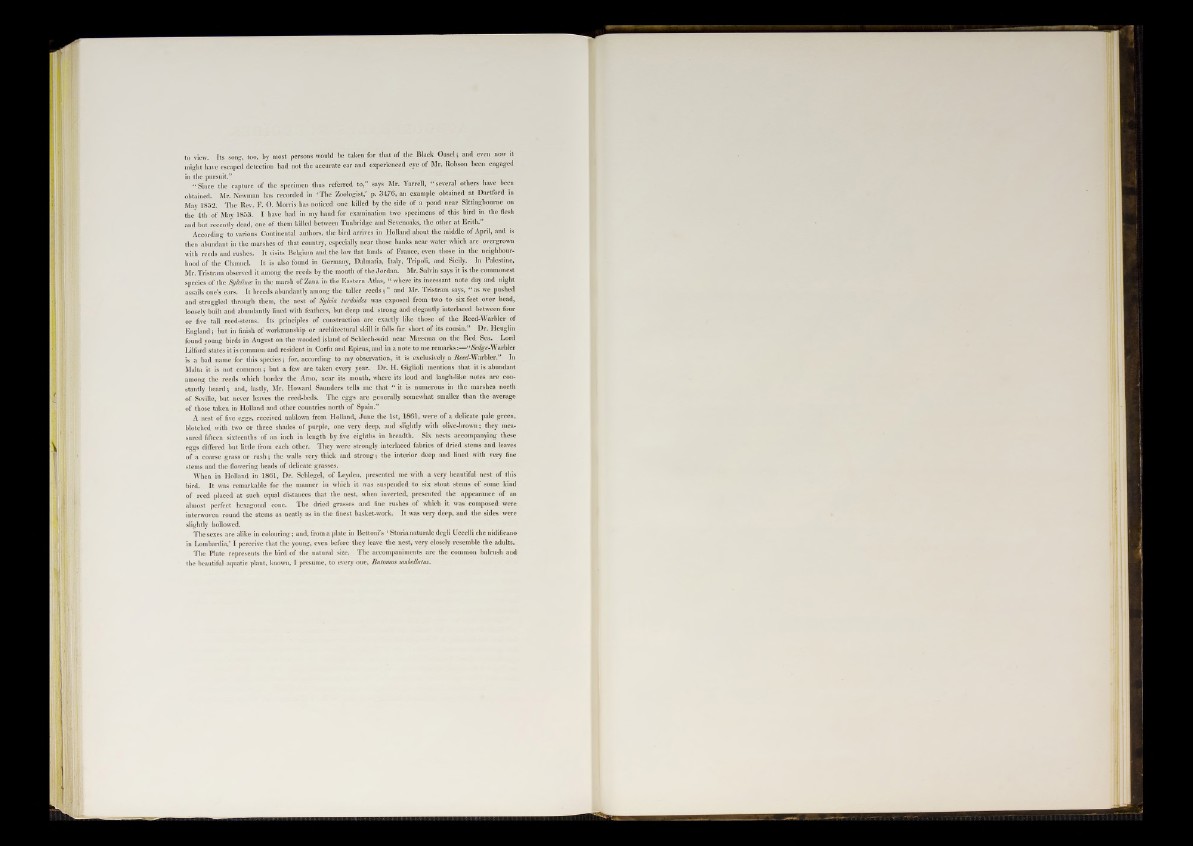
to view. Its song, too, by most persons would be taken for that of the Black Ousel; and even now it
might have escaped detection had not the accurate ear and experienced eye of Mr. Rohson been engaged
in the pursuit.”
“ Since the capture of the specimen thus referred to,” says Mr. Yarrell, “ several others have been
obtained. Mr. Newman has recorded in ‘The Zoologist,’ p. 3476, an example obtained a t Dartford in
May 1852. The Rev. F. O. Morris has noticed one killed by the side of a pond near Sittingbourne on
the 4th of May 1853. I have had in my hand for examination two specimens of this bird in the flesh
and but recently dead, one of them killed between Tunbridge and Sevenoaks, the other at Erith.”
According to various Continental authors, the bird arrives in Holland about the middle of April, and is
then abundant in the marshes of that country, especially near those banks near water which are overgrown
with reeds and rushes. It visits Belgium and the low flat lands of France, even those in the neighbourhood
of the Channel. It is also found in Germany, Dalmatia, Italy, Tripoli, and Sicily. In Palestine,
Mr. Tristram observed it among the reeds by the mouth of the Jordan. Mr. Salvin says it is the commonest
species of the Sylviince in the marsh of Zana in the Eastern Atlas, “ where its incessant note day and night
assails one’s ears. It breeds abundantly among the taller reeds; ” and Mr. Tristram says, “ as we pushed
and struggled through them, the nest of Sylvia turdoides was exposed from two to six feet over head,
loosely built and abundantly lined with feathers, but deep and strong and elegantly interlaced between four
or five tall reed-stems. Its principles of construction are exactly like those of the Reed-Warbler of
England; but in finish of workmanship or architectural skill it falls far short of its cousin.” Dr. Heuglin
found young birds in August on the wooded island of Schlech-said near Massaua on the Red Sea. Lord
Lilford states it is common and resident in Corfu and Epirus, and in a note to me remarks:—“jfei^e-Warbler
is a bad name for this species; for, according to my observation, it is exclusively a i?«*/-Warbler.” In
Malta it is not common; but a few are taken every year. Dr. H. Giglioli mentions that it is abundant
among the reeds which border the Arno, near its mouth, where its loud artd laugh-like notes are constantly
heard; and, lastly, Mr. Howard Saunders tells me that “ it is numerous in the marshes north
of Seville, but never leaves the reed-beds. The eggs are generally somewhat smaller than the average
of those taken in Holland and other countries north of Spain.”
A nest of five eggs, received unblown from Holland, Juue the 1st, 1861, were of a delicate pale green,
blotched with two or three shades of purple, one very deep, and slightly with olive-brown; they measured
fifteen sixteenths of an inch in length by five eighths in breadth. Six nests accompanying these
eg<rs differed but little from each other. They were strongly interlaced fabrics of dried stems and leaves
of a coarse grass or rush; the walls very thick and strong; the interior deep and lined with very fine
stems and the flowering heads of delicate grasses.
When in Holland in 1861, Dr. Schlegel, of Leyden, presented me with a very beautiful nest of this
bird. It was remarkable for the mauuer in which it was suspended to six stout steins of some kind
of reed placed at such equal distances that the nest, when inverted, presented the appearance of an
almost perfect hexagonal cone. The dried grasses and fine rushes of which it was composed were
interwoven round the stems as neatly as in the finest basket-work. It was very deep, and the sides were
slightly hollowed.
The sexes are alike in colouring; and, from a plate in Bettoni’s ' Storianaturale degli Uccelli che nidificano
in Lombardia,’ I perceive that the young, even before they leave the nest, very closely resemble the adults.
The Plate represents the bird of the natural size. The accompaniments are the common bulrush and
the beautiful aquatic plant, knowu, I presume, to every one, Butomus umbellatus.